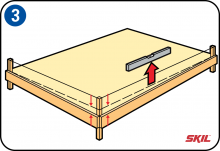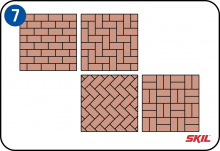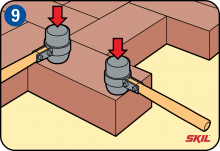-
How big is the slope?
Rainwater should easily run off the patio. A slope of 2 cm per meter is usually enough. That will allow the rainwater to run off into a drain or onto the garden or road.
-
Marking out the edges
To start with, mark out the edges of the patio with small wooden posts and a cord. Drive the posts vertically into the ground at 1 meter intervals. A depth of 25 to 30 cm is usually enough. If you want the patio to extend right up to an exterior door, the highest part of the patio should be at least 3 cm lower than the doorstep.
-
Defining the slope
To define the slope of the patio, you first need to set a fixed point. Using a spirit level and a straight plank, mark this point out on the marker post that’s nearest to the house. Fix the cord at that height on the first post, and then 2 cm lower on each following post. Then place the edging planks along the cord at the marked heights.
-
Patio tiles on a sand bed
If you want to lay the patio tiles on a bed of sand, you need a layer of sand with a depth of 10 cm. Spread the sand out over the entire surface so it is just a little higher than the edging planks. Then spread a 2 mm stabilizing layer of cement powder over the sand bed. Rake this layer flat and stamp the sand bed firmly into place. Then smooth the surface over with a straight plank.
-
Laying the tiles
Lay the tiles flat and in a straight row without walking on the sand bed. The tiles must fit together neatly and must lay securely as soon as you put them in place. The second row of tiles should be offset by half a tile from the first row, to give the patio a regular bond pattern. You can work out in advance how many half tiles you’ll need to minimize the number of tiles you have to cut. It’s best to cut the tiles using an angle grinder with a stone cutting disc or a diamond disc of the right diameter. Make sure you wear safety glasses, ear defenders and working gloves when you’re using an angle grinder.
-
Edge courses
Once you’ve laid all the tiles, you can finish the sides with edging blocks or concrete edge courses. After that you can fill-up with garden soil around the sides of the patio.
-
Cobblestones
If you want a sturdy patio with a rustical look, you can use cobblestones instead of tiles. These are made of stone or concrete, and are available in different colors. The number of stones you need depends on the type. You can lay the stones in a parallel bond pattern or at an angle of 45 degrees. In the latter case you’ll need slightly more stones. Other possible variations are running bond, 45° or 90° herringbone bond, parquet bond, random bond and half stone bond patterns.
-
Stabilized sand
If you want to make a patio or driveway really strong, you can lay the stones in a stabilized sand bed. This is a mixture of sand and cement in fixed proportions. For patios you should use 150 kg/m³ of the mixture, and for driveways 200 kg/m³. You can also mix stabilized sand yourself. The proportions are then 1:4 and 1:5, respectively. That means 1 part (shovels or sacks) of cement to 4 or 5 parts of sand. If you need a large quantity it’s a good idea to hire a cement mixer.
-
Laying cobblestones
Without walking on the sand bed, lay the cobblestones straight into the right places and make sure they fit together neatly. Tap them into place at the right height with a rubber hammer. Make sure you always tap the cobblestones at the edges, and not in the middle, so they don’t break. If a stone is too low or too high, take it out and add or remove a little sand under it. Then replace the stone and tap it back into place.
-
Row by row
Lay the cobblestones row by row and level the sand to the right height for the next row each time. Check from different directions while you’re working that the patio is level and the cobblestone bond pattern is straight and regular. After that you can cut the stones to the right sizes for the side edges. Use an angle grinder with a stone cutting disc or a diamond disc of the right diameter.
-
Vibrating plate compactor
If you’re laying a driveway, and the stones have to support the weight of your car, it’s best to compact them with a vibrating plate. You can also use the vibrating plate to compact the sand bed before you lay the stones. After you’ve leveled and compacted the sand bed you can lay the stones in the desired pattern. When all the stones have been laid you can compact them into place with the vibrating plate. This working method is a lot faster than tapping each stone into place individually.
-
Spreading sand
When you’ve laid the patio or driveway, spread plenty of silver sand over it. Use a broom to sweep the sand into the gaps. This takes quite some time, but it’s worth doing carefully because weeds will then have little chance to grow in the gaps and the stones will stay securely in place. After a few days, when all the gaps are filled, you can sweep away the excess sand.












